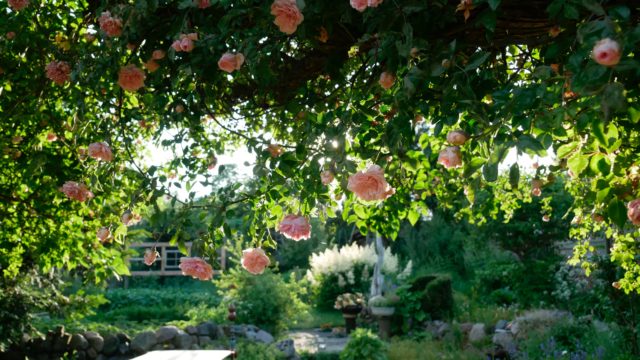Harvest season: that magical time when plants team with fruits, foliage and flowers. But when plants are weighed down by their own blooms, knocked to the ground in stormy winds, or simply overgrown, could your garden be…too full?
If it looks less like Eden and more like a botanical blunder, it’s time to take action! But how do you know which plants to stake, which to cut back, and which to simply let be? This guide to late-season garden maintenance will help you make the call!
WHEN TO CUT BACK
- Blooms are past their prime, going to seed, or totally gone
- Leaves are yellow, moldy or decomposing

If this list looks familiar, it’s probably time to give your growth a trim. Lilies, iris, and the like can be snipped directly at the base. If your still enjoying the greenery, just cut the stalk and leave the leaves. Otherwise, cut the whole plant as close to the ground as possible, leaving the bulbs to safely winter underground.
For woodier plants––including roses, dahlias, and daisies––cut each spent twig back to the site of the next new growth. This is what is called the “apical meristem.” Be careful–sometimes the new growth hasn’t yet materialized, or is still very very small. (If you want more information about apical meristems, check out this article on how pruning stimulates growth)
WHEN TO STAKE
- Blossoms and fruits have tipped over but are otherwise in their full glory
- Plants are growing at an odd angle and/or encroaching on neighboring plants
- Showpieces like blooms, fruits, or decorative foliage are hidden by unbalanced growth patterns

Peonies, dahlias, and other top-heavy plants often need help holding up their weight. Even when preemptively planted in supportive cages, they often need a little TLC by the end of the summer. Make sure you don’t bend the stem too much if you add a dowel or stake for support––the plant may have grown at an angle, and it could snap if straightened too much. Instead, use the natural direction of the stem as a guide. Twine, velcro (pictured to the left, supporting delphiniums), or gardening clips can be helpful to gently attach the plant to the supporting structure.
WHEN TO LET IT BE
- The plant might be a bit overgrown but appears relatively undamaged
- The growth does not interfere with other plants, or other elements of your yard*
- You like the wild look of full growth

Let nature do its thing!
*Though picturesque, plants growing up building can cause serious damage! Keep the quaintness, while avoid a headache, by installing a plant-friendly jungle-gym such as a trellis near (but not directly on!) your house or garden shed.
Professional support for this sort of project ensures peace of mind, an easy process, and excellent outcomes. Contact our team of professional landscapers at Nature Works Land Care. We’re here to help!


